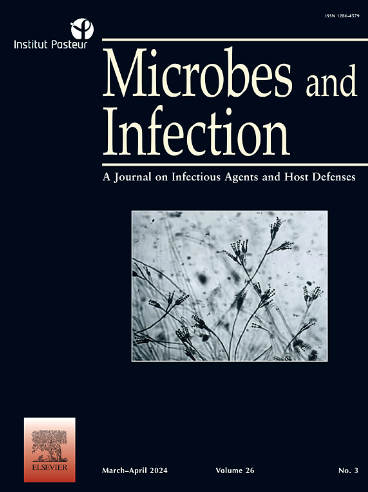沙眼衣原体通过p53/SLC7A11通路调控铁下垂,促进生殖。
IF 2.7
4区 医学
Q3 IMMUNOLOGY
引用次数: 0
摘要
沙眼衣原体(Ct)感染是世界范围内最普遍的性传播感染之一。然而,其临床进展往往是潜伏的和长期的。了解Ct影响细胞死亡途径的机制对于阐明这种细胞内细菌的致病过程至关重要。铁死亡是一种新发现的程序性细胞死亡形式,其特点是脂质过氧化物的铁依赖性积累。尽管其相关性,Ct和铁下垂之间的相互作用仍然很少研究。在本研究中,我们首先在体外Ct急性感染模型下进行了基于RNA测序数据的生物信息学分析。生物信息学分析显示,铁下垂和p53信号通路中差异表达基因显著富集。随后,我们通过对铁沉相关蛋白的表达分析验证了Ct抑制宿主铁沉的假设。进一步的细胞增殖,细胞内亚铁荧光和脂质过氧化分析,多方面观察表型。在机制上,我们发现Ct抑制铁下垂是通过调节宿主p53/SLC7A11途径起作用的。最后,间接免疫荧光分析表明,铁下垂降低了Ct后代的包涵体形成单位(IFUs),从而影响其繁殖,这在一定程度上解释了Ct抵抗宿主铁下垂的生存策略。本文章由计算机程序翻译,如有差异,请以英文原文为准。
Chlamydia trachomatis regulates ferroptosis through the p53/SLC7A11 pathway to promote reproduction
Genital tract Chlamydia trachomatis (Ct) infection is one of the most prevalent sexually transmitted infections (STIs) worldwide. However, its clinical progression is often insidious and prolonged. Understanding the mechanisms by which Ct influences cell death pathways is crucial for elucidating the pathogenic processes of this intracellular bacterium. Ferroptosis, a newly identified form of programmed cell death, is characterized by the iron-dependent accumulation of lipid peroxides. Despite its relevance, the interaction between Ct and ferroptosis remains poorly studied. In the present study, we first performed bioinformatics analysis based on RNA sequencing data under an in vitro model of Ct acute infection. Bioinformatics analysis revealed significant enrichment of differentially expressed genes in ferroptosis and p53 signaling pathways. Subsequently, we validated the hypothesis that Ct inhibits host ferroptosis by expression assays of ferroptosis-related proteins. Further cell proliferation, intracellular ferrous iron fluorescence, and lipid peroxidation assays multifaceted observations of the phenotype. Mechanistically, we found that Ct inhibition of ferroptosis acts by regulating the host p53/SLC7A11 pathway. Finally, indirect immunofluorescence assays demonstrated that ferroptosis decreases inclusion forming units (IFUs) of Ct progeny and thus affects its reproduction, which partly explains Ct's survival strategy of resisting host ferroptosis.
求助全文
通过发布文献求助,成功后即可免费获取论文全文。
去求助
来源期刊

Microbes and Infection
医学-病毒学
CiteScore
12.60
自引率
1.70%
发文量
90
审稿时长
40 days
期刊介绍:
Microbes and Infection publishes 10 peer-reviewed issues per year in all fields of infection and immunity, covering the different levels of host-microbe interactions, and in particular:
the molecular biology and cell biology of the crosstalk between hosts (human and model organisms) and microbes (viruses, bacteria, parasites and fungi), including molecular virulence and evasion mechanisms.
the immune response to infection, including pathogenesis and host susceptibility.
emerging human infectious diseases.
systems immunology.
molecular epidemiology/genetics of host pathogen interactions.
microbiota and host "interactions".
vaccine development, including novel strategies and adjuvants.
Clinical studies, accounts of clinical trials and biomarker studies in infectious diseases are within the scope of the journal.
Microbes and Infection publishes articles on human pathogens or pathogens of model systems. However, articles on other microbes can be published if they contribute to our understanding of basic mechanisms of host-pathogen interactions. Purely descriptive and preliminary studies are discouraged.
 求助内容:
求助内容: 应助结果提醒方式:
应助结果提醒方式:


